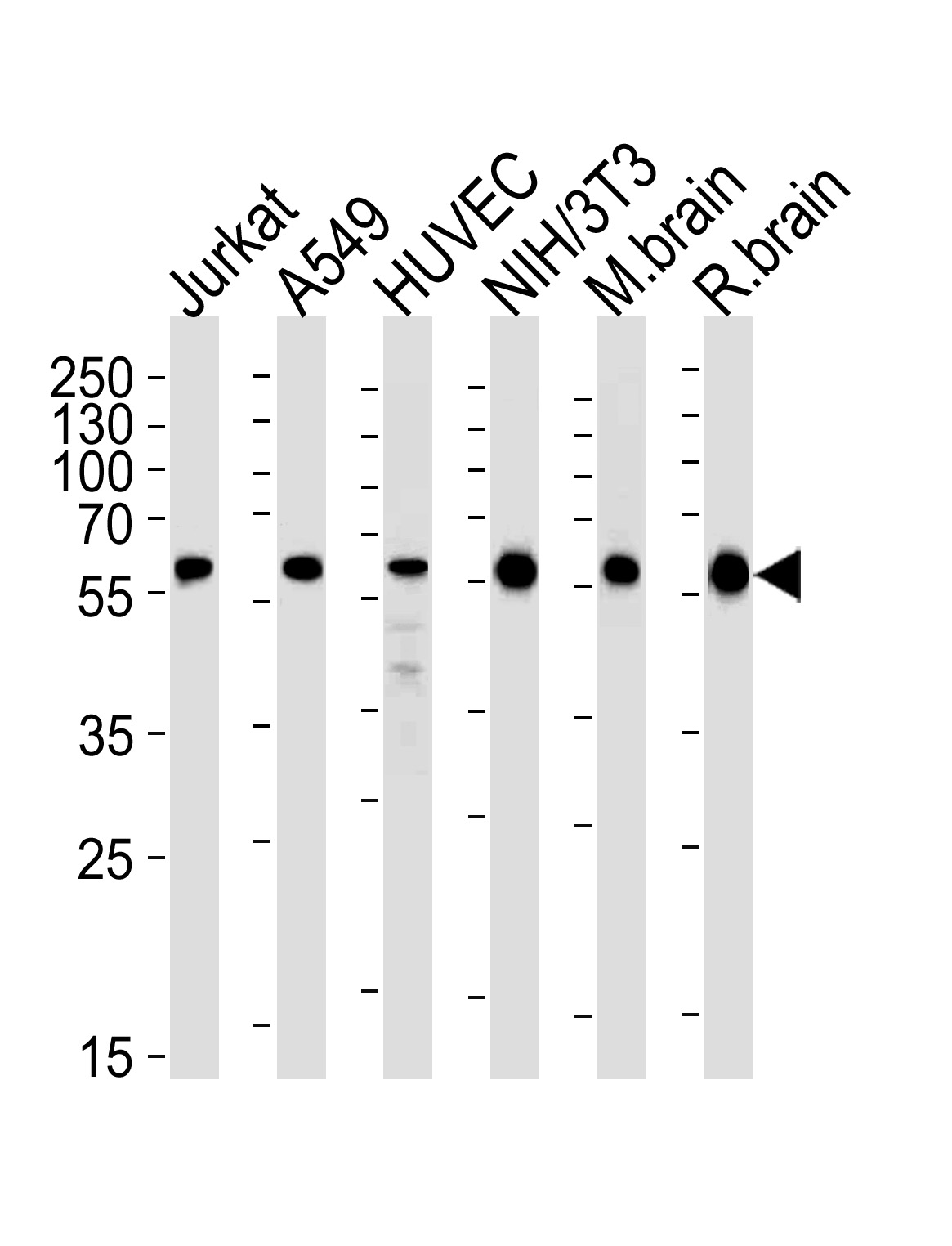Mouse anti-RAD23B Monoclonal Antibody(N-term)(1228CT409.120.123.135)描述别名宿主特异性反应种属应用分子量类型克隆号同种型储存/保存方法研究领域背景说明细胞定位UniProt参考文献
| 概述 | |
| 描述 |
Purified Mouse Monoclonal Antibody (Mab)
|
| 别名 |
RAD23B抗体;UV excision repair protein RAD23 homolog B; HR23B; hHR23B; XP-C repair-complementing complex 58 kDa protein; p58; RAD23B
|
| 宿主 |
Mouse
|
| 特异性 |
This RAD23B antibody is generated from a mouse immunized with a KLH conjugated synthetic peptide between 1-409 amino acids from the N-terminal region of human RAD23B.
|
| 反应种属 |
Human, Mouse, Rat
|
| 应用 |
WB~~1:1000
|
| 分子量 |
Predicted molecular weight: 43kD
Disclaimer note: The observed molecular weight of the protein may vary from the listed predicted molecular weight due to post translational modifications, post translation cleavages, relative charges, and other experimental factors. |
| 性能 | |
| 类型 |
Monoclonal Antibody
|
| 克隆号 |
1228CT409.120.123.135
|
| 同种型 |
IgG1,κ
|
| 储存/保存方法 |
Maintain refrigerated at 2-8°C for up to 2 weeks. For long term storage store at -20°C in small aliquots to prevent freeze-thaw cycles.
|
| 研究领域 |
Crown Antibodies
|
| 靶标 | |
| 背景说明 |
Multiubiquitin chain receptor involved in modulation of proteasomal degradation. Binds to polyubiquitin chains. Proposed to be capable to bind simultaneously to the 26S proteasome and to polyubiquitinated substrates and to deliver ubiquitinated proteins to the proteasome. May play a role in endoplasmic reticulum- associated degradation (ERAD) of misfolded glycoproteins by association with PNGase and delivering deglycosylated proteins to the proteasome. The XPC complex is proposed to represent the first factor bound at the sites of DNA damage and together with other core recognition factors, XPA, RPA and the TFIIH complex, is part of the pre-incision (or initial recognition) complex. The XPC complex recognizes a wide spectrum of damaged DNA characterized by distortions of the DNA helix such as single-stranded loops, mismatched bubbles or single-stranded overhangs. The orientation of XPC complex binding appears to be crucial for inducing a productive NER. XPC complex is proposed to recognize and to interact with unpaired bases on the undamaged DNA strand which is followed by recruitment of the TFIIH complex and subsequent scanning for lesions in the opposite strand in a 5′-to-3′ direction by the NER machinery. Cyclobutane pyrimidine dimers (CPDs) which are formed upon UV-induced DNA damage esacpe detection by the XPC complex due to a low degree of structural perurbation. Instead they are detected by the UV-DDB complex which in turn recruits and cooperates with the XPC complex in the respective DNA repair. In vitro, the XPC:RAD23B dimer is sufficient to initiate NER; it preferentially binds to cisplatin and UV-damaged double-stranded DNA and also binds to a variety of chemically and structurally diverse DNA adducts. XPC:RAD23B contacts DNA both 5′ and 3′ of a cisplatin lesion with a preference for the 5′ side. XPC:RAD23B induces a bend in DNA upon binding. XPC:RAD23B stimulates the activity of DNA glycosylases TDG and SMUG1.
|
| 细胞定位 |
Nucleus. Cytoplasm. Note=The intracellular distribution is cell cycle dependent. Localized to the nucleus and the cytoplasm during G1 phase. Nuclear levels decrease during S- phase; upon entering mitosis, relocalizes in the cytoplasm without association with chromatin
|
| UniProt |
P54727
|
| 参考文献 | |
| 参考文献 |
Masutani C.,et al.EMBO J. 13:1831-1843(1994).
Huang X.,et al.J. Androl. 25:363-368(2004). Ota T.,et al.Nat. Genet. 36:40-45(2004). Humphray S.J.,et al.Nature 429:369-374(2004). Mural R.J.,et al.Submitted (JUL-2005) to the EMBL/GenBank/DDBJ databases. |
实验结果图

Western blot analysis of lysates from Jurkat, A549, HUVEC, mouse NIH/3T3 cell line and mouse brain, rat brain tissue lysates (from left to right), using RAD23B Antibody (N-term) (Cat. # JP100420). JP100420 was diluted at 1:1000 at each lane. A goat anti-mouse IgG H&L(HRP) at 1:3000 dilution was used as the secondary antibody. Lysates at 35μg per lane.
